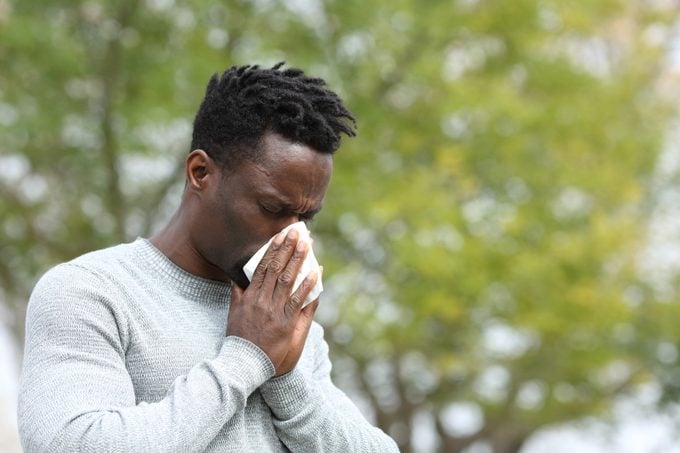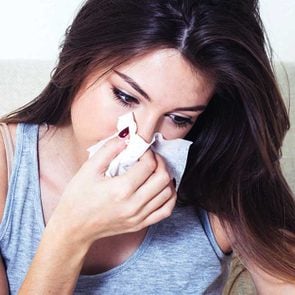13 Signs You Have Hay Fever Allergies
Updated: Mar. 08, 2022
Sneezing, congestion, watery and puffy eyes—is it a summer cold or allergies? Here's how to identify hay fever symptoms, plus ways to treat and prevent allergies.
The misery of hay fever season
A never-ending runny nose, sneezing, and watery eyes can really put a damper on your summer fun. Yet for so many Americans, these symptoms of hay fever are part and parcel of the season.
And, no, you’re not actually allergic to hay. Nor are you likely to have a fever.
Back in the 19th century, some doctors believed the smell of hay harvested in the summer and fall was responsible for runny noses and itchy, watery eyes. Voilà: the term hay fever was born.
Eventually, pollen (and other allergens) proved to be the real culprit.
What is hay fever?
Let’s break down what hay fever is, beginning with its medical name: allergic rhinitis.
“Allergic” means you’re hypersensitive to an allergen. “Rhinitis” means inflammation of the nose. Put it together and you get a hypersensitivity to allergens, symptoms of which affect the nose.
(But if you’re sniffling or congested, you already knew that.)
The majority of allergic rhinitis is caused by the pollen of wind-pollinated plants: trees, grasses, and weeds.
Plants pollinated by insects don’t usually trigger the same magnitude of symptoms. Mold and pet dander, however, can definitely trigger symptoms.
How you react to these allergens is up to your immune system, which has a mind of its own. And it’s not fair, but one individual’s immune system might ignore an allergen while another’s might go to war over it.
Over 19 million adults in the United States have hay fever, according to the Asthma and Allergy Foundation of America.
If you’re allergic to pollen, mold, or pet dander, for example, your body sees the allergen as an unwelcome guest—and proceeds to kick it out.
Its first line of defense is to produce antibodies called immunoglobulin E (IgE). These antibodies travel to cells that release histamines and other chemicals, which cause symptoms in the nose, eyes, ears, throat, the roof of the mouth, and skin.
Each type of IgE has a specific detector for each type of allergen. This explains why some people are allergic to cat dander and not pollen, and why some people have allergic reactions to multiple allergens.
Why does sensitivity develop?
It’s still a mystery why the body’s immune system sees certain substances as foreign invaders and overreacts. Just as unclear is why some people have allergic reactions while others do not.
Allergists do know that a family history is a significant risk factor, though.
“The majority of adults who have allergies developed them into their adolescent years, through high school and college,” says Tina Sindher, MD, an allergist at Standford Health Care in San Jose, California.
That said, allergies can develop at any age.
In fact, Daniel Sullivan, MD, an allergist, otolaryngologist, and surgeon specializing in allergies at the Health First Medical Group in Melbourne, Florida, says his now 97-year-old patient sought help for his allergies at the age of 94 because his persistent postnasal drip, mucus, and constant throat clearing were “riding on his last nerve.”
“I think it might be an exaggeration, but he said it was the best decision of his life to seek allergy treatment,” he says.
When does hay fever occur?
Under the hay fever/allergic rhinitis umbrella lies perennial and seasonal allergic rhinitis. You can have just one or experience the double whammy of seasonal and perennial allergies.
Perennial allergic rhinitis is caused by allergens with no calendar preferences. The most common indoor offenders are mold, animal dander, dust mites, and cockroach debris.
People with allergic rhinitis may also be sensitive to perfume, smoke, or cold, dry air. The condition can aggravate asthma and cause sinus and ear conditions.
The seasonal variety is what we typically think of when we hear hay fever. It occurs in the spring and fall when pollen from trees, grasses, and weeds are swirling around. Yet more and more research shows climate change is making pollen season longer.
A recent study published in Scientific Reports found pollen season grew by about half a week per year from 2002 through 2019.
Though the study was limited to the pollen collected in the San Franciso Bay area, research in the Proceedings of the National Academy of Sciences found that sniffle season is starting earlier and lasting longer in other parts of the country too.
For the Bay area, “the pollen season is eight to nine weeks longer than in 2002,” says one of the study’s authors, Mary Prunicki, MD, director of air pollution and health research at the Sean N. Parker Center for Allergy and Asthma Research at Stanford University.
Dr. Prunicki suggests people with allergies plan ahead.
“It means recalibrating the timing of when you start antihistamines because you need to be on it prior to the season hitting to be most effective,” she says.
Essentially, you’ll be taking antihistamines even earlier and longer to keep allergy symptoms at bay.

Hay fever symptoms
Seasonal and perennial allergic rhinitis symptoms can feel a lot like a cold. There are a few ways they are different, though.
Allergy symptoms tend to come on quickly after exposure to an allergen. Colds come on gradually. Allergy symptoms are steady if the allergen is within breathing range. Cold symptoms taper off in a week or two.
Keep an eye out for patterns. Do you have symptoms about the same time each year? Do you experience symptoms every time you visit a certain place or person (like your friend with a cat)? They’re probably allergy-related.
Allergy symptoms include the following (you might have just one or multiple at the same time):
- Sneezing
- Stuffy nose
- Runny nose
- Mucus in the throat
- Throat clearing
- Itchy eyes
- Watery eyes
- Bloodshot eyes
- Puffy eyes
- Itchy nose
- Itchy ears
- Itchiness on the roof of the mouth
- Wheezing
The only definitive way to know whether you have allergies, however, is to get tested.
How to prevent seasonal hay fever at home
If there were such a thing, allergists would write “avoidance” on a prescription pad. That’s the only way to dodge allergens and avoid triggering symptoms. Is this feasible? Sometimes.
For example, you might be able to fend off pollen allergies by staying inside with the windows closed on days when the pollen count is high.
If you can’t evade allergens entirely, you can at least mitigate their effects by limiting the exposure.
Take these steps to minimize seasonal allergens:
Limit exposure
Keep your house and car windows closed, which will limit how much pollen gets into your space.
If possible, avoid spending a lot of time outdoors during peak pollen days. Here’s where to find pollen counts in your area.
Wear proper accessories
Wear a surgical or N95 mask to prevent breathing in allergens. Remember to wear sunglasses and a hat to keep pollen out of your eyes and hair.
Ditch the shoes indoors
As soon as you come in from the outdoors, take off your shoes. That’ll help you avoid tracking allergens all over the house.
Wash accordingly
Shower and wash your hair of pollen. Be sure to wash the clothing you wore outside before wearing it again.
And don’t forget to wash your sheets and other bed linens frequently. It will help keep indoor and outdoor allergens away.
How to avoid year-round hay fever at home
As with seasonal allergies, the best way to avoid perennial allergies is to avoid allergens. And as with seasonal allergies, that’s only sometimes doable.
You can politely decline a dinner invitation to someone’s house if their cat sends you into a sneezing frenzy. But you probably won’t be able to avoid dust mites entirely.
Here are some tips for minimizing the most common perennial indoor allergens, including dust mites, indoor mold, cockroach droppings, and pet dander:
Tend to your bed
Dust mites thrive in humid and warm conditions. Wash and dry bed linens frequently to kill the bugs.
Another tip: encase your pillows, mattress, and box springs in allergen-resistant covers. That will prevent dust mites from penetrating your bedding.
Use a vacuum with a HEPA filter
Clean your carpet using a vacuum with a HEPA filter a few times a week. Carpet traps outdoor and indoor allergens. Consider removing it and install wood, tile, or laminate flooring if your allergies are severe.
Tackle humidity
Mold thrives in humid environments. You can reduce indoor mold with a dehumidifier. And fix household leaks—they can lead to mold.
Control cockroaches
Control cockroaches by covering food and garbage. If you still see dropping, buy traps or bait, or call an exterminator.
Take care of your pet
Even if you’re not allergic to pet dander, the pollen your pet rolls in could trigger symptoms. Either way, bathe and groom pets often. Wear a mask if necessary.
Give your pet its own bedroom. When your pets sleep in your bed or in the same room, you’re exposed to a steady stream of allergens.
Clean the right way
Use damp microfiber cloths to prevent dust from moving around while you’re dusting. That’s important because if cleaning releases dust particles in the air, your allergies can act up.
Do air purifiers help with allergies?
They might, but in most cases, Dr. Sullivan recommends them for the bedroom only.
“You spend the most hours of a day in the bedroom, and you can position it so it blows right on your face,” he says.
Of course, if you’re now working from home, you might want a portable or personal air purifier that you can use in your home office during the day and the bedroom at night.
Air purifiers aren’t too expensive in most cases, but the HEPA filters can be pricey.
“The average air purifier might be around $100, but the filters cost approximately $70,” Dr. Sullivan says.
Since you should replace filters every three months, that can add up quickly. Plus, if you have pets, the filter can fill up with pet hair, defeating the purpose, he says.
Still, air purifiers for pets might be helpful if you keep the door shut to your bedroom and keep your pet out.
If you have central air conditioning, a more practical option is to use high-quality HEPA filters and change them regularly before purchasing an air purifier, Dr. Sullivan says.

Allergy treatments
A proactive approach is almost always more successful when it comes to combating wretched allergy symptoms.
Allergy medicine (prescription or over the counter) taken before exposure can decrease or halt the release of the histamines that prompt an allergy attack.
There are some exceptions to the rule. Some people may respond well when they take medicine after exposure, but that doesn’t always work.
“The best example I have is a cat allergy,” Dr. Sullivan says. “If you take a Claritin before you go to someone’s house with a cat, you’re generally going to have a much better visit than if you wait until you’re sneezing,” says Dr. Sullivan.
Dr. Sindher agrees. “I always recommend pretreating at least 30 minutes ahead of the exposure,” she says.
Once inflammation sets in, it takes much longer for medicine to help. It might not help at all, depending on the severity of your allergy.
Antihistamines
Many antihistamines are available without a prescription. If you don’t get relief, your doctor may prescribe a more potent antihistamine.
Antihistamines fall into one of two categories. First-generation drugs are sedating and may cause drowsiness. The second-generation meds are typically labeled “nondrowsy.” But we warned: they still may cause some drowsiness.
Nasal sprays
Nasal steroid sprays are very effective at controlling inflammation in the nose, but it may take several days or up to a couple of months of daily use before you feel complete relief.
Decongestants
Decongestants are available without a prescription or by prescription in tablet, liquid, or nasal spray forms to help relieve a stuffy nose.
Heed any warning labels before taking them.
Some contain pseudoephedrine. It’s a type of stimulant that people who have certain conditions, such as heart disease, a stroke, and high blood pressure, should avoid.
“It definitely raises your heart rate and raises your blood pressure. It’s kind of like a 5-Hour Energy,” says Dr. Sullivan. “It will help decongest the nose and help with some of the drip and drainage, but usually, the tradeoff is not good.”
Allergy shots
Antihistamines and nasal sprays might be adequate for temporary relief of hay fever, but allergy symptoms can return as soon as you’re done taking them.
Allergy shots might be the answer to your prayers when you’re allergic to several things and in misery most of the year.
You’ll need to get an allergy test first to identify what allergens you’re allergic to.
Allergy shots work by introducing your body to an allergen in increasing doses. The goal is to build up the body’s immune system. Over time, the body becomes less sensitive to allergens.
The process requires patience and a time commitment, as allergens are gradually introduced into the body.
The initial stage may require one to two shots a week to reach the target dose. Once the target dose is achieved, the maintenance phase begins.
A shot every two to four weeks is typical for about three to five years.
For many, allergy shots provide long-term relief and sometimes even remission of hay fever symptoms.
When Dr. Sindher talks to patients considering allergy shots, she breaks down the potential of effectiveness into thirds.
“For a third of people, allergy shots will work wonders, with no more allergy symptoms,” she says. “Another third may see some improvement and have better-controlled symptoms. And in a third of people, there is no improvement or they have severe reactions to the shot and must discontinue.”
Sublingual tablets
This type of allergy treatment is currently limited to treat ragweed, pollen, and dust mites.
So if you also have allergies to pet dander and mold, your allergist will likely recommend another option. That being said, sublingual tablets can be quite effective and provide long-term relief for ragweed, pollen, and year-round dust mites.
You’ll need an allergy test to determine if one of these allergens is causing your symptoms. Tablets are dissolved under the tongue and are usually taken daily.




